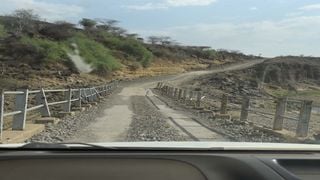
Kapedo Bridge at the border of Turkana and Baringo counties on February 17, 2023. Several people have been shot dead at the bridge by bandits who lay ambush from the cliffs above.
| Jared Nyataya | Nation Media GroupThe terrifying experience of crossing the dreaded Kapedo Bridge
What you need to know:
- Locals say the dreaded Kapedo bridge was built during colonial times
- It is too narrow for two vehicles coming from opposite directions to pass at the same time
- It is also a drift, forcing motorists to slow down as they descend the road and climb up to either Kapedo or Chemolingot in Tiaty West
- Armed assailants have taken advantage of the winding road and rough terrain to hide on the cliffs, because they can easily monitor approaching vehicles
A narrow, rocky, rugged and dusty road leads to the dilapidated Kapedo Bridge on the border of Baringo and Turkana counties.
The nearly 100-metre-long road is nestled in a valley surrounded by towering rocky cliffs, making it a prime spot for armed criminals to scout and ambush unsuspecting motorists plying the route, as well as their perceived enemies — security officers.
The area has deep gullies caused by years of erosion, making it a perfect hideout for the bandits.
Beneath the dreaded Kapedo Bridge is the River Suguta, which flows towards Silale. The permanent river has been a source of prolonged conflict between the neighbouring communities of Pokot and Turkana, who share a border, especially during the dry season.
Locals say the bridge was built during colonial times. It is too narrow for two vehicles coming from opposite directions to pass at the same time. It is also a drift, forcing motorists to slow down as they descend the road and climb up to either Kapedo or Chemolingot in Tiaty West, more than 34km away.
Has claimed dozens of lives
The Kapedo Bridge, about two kilometres from the disputed Kapedo town on the border of Tiaty East and Turkana East sub-counties, has claimed dozens of lives —snuffed out by armed criminals, including security officers deployed in the troubled area to restore sanity.
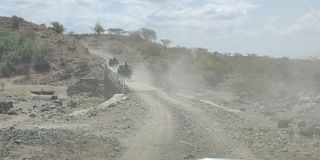
A long view of Kapedo bridge where many people, including security officers have been ambushed and killed by bandits lying in wait on the cliffs above.
On January 17, 2021, for example, a General Service Unit (GSU) commander stationed in Kapedo was shot dead as he responded to a distress call from officers who had been attacked by armed criminals in the area.
In the attack, Emadau Tebakol, a senior security officer, was shot dead and two others seriously injured after they were ambushed at Ameyan, seven kilometres from Kapedo, a few metres from the dreaded bridge.
The incident happened at 3pm when some security officers attached to the Rapid Deployment Unit (RDU) were travelling from Lomelo in Turkana East to Nairobi via Marigat when they were ambushed and attacked by armed criminals a few metres from the dreaded bridge.
One of the officers in the police truck was seriously injured.
Then Baringo County Police Commander Robinson Ndiwa said officers from the General Service Unit and RDU in Kapedo had responded to rescue their colleagues from the ambush when they were also attacked a few metres from the first scene.
Four days later, bandits staged another ambush at the precarious bridge, fatally shooting RDU chief inspector Moses Lekariab, a driver and police constable Benson Kaburu. In addition to the security officers, dozens of civilians were also shot dead by criminals at the same spot, either while travelling in vehicles, on foot or going about their daily activities of herding, fetching water or firewood.
Not a walk in the park
A security officer who served in insecure Kapedo for more than a year, and who spoke to Nation.Africa on condition of anonymity for fear of victimisation, said crossing the bridge is not a walk in the park, even for armed police officers.
However, it is unavoidable for them because they have to patrol the villages or go to Marigat or Chemolingot towns for their daily activities.
"When we approach the bridge, we are extra vigilant because we know the bandits are hiding in the cliffs above the bridge," the officer said.
"Because of the rugged terrain, even one criminal can manage to attack a truck full of policemen because he is on a high point and can aim at the vehicle crossing the bridge into the valley. Most of the time, they hide on the rocks on the top of the cliff, shoot at the motorists and disappear to their hideouts either in the gorges or in the Silale Hills," the police officer revealed.
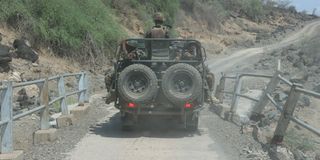
An armored military vehicle scaling the road across Kapedo bridge in a past picture.
Mr John Ekal, a resident of Kapedo, told Nation.Africa where the rough terrain and winding road have contributed to the loss of many lives at the dreaded spot.
"The bridge is located in a valley defined by rough terrain. Motorists heading to either Kapedo or Chemolingot have to slow down on the winding road as they approach the bridge before they can climb the incline. Armed assailants have taken advantage of this to hide on the cliffs, because they can see vehicles coming from both directions, and then ambush them," said Mr Ekal.
Vantage spots
"They hide at vantage points where they can't be seen until they strike. Even if you see them, it is too late for you because you cannot drive fast. If you are in a valley, you have to slow down and then climb up, which can take 10 minutes. By the time you cross the bridge, the bandits will have caught up with you. They just wait for you to slow down and then attack," he explained.
The river below the bridge has also contributed to attacks, with criminals posing as herders grazing and watering their cattle during the dry season. Across the bridge, on the way to Kapedo, is an area rich in grazing land, which has also fuelled inter-communal feuds over limited resources.
According to locals in Kapedo, so many people, including security officers, have been killed here.
"I remember some time ago, a food vendor at the Kapedo shopping centre was ambushed by bandits at the bridge as he was returning to Chemolingot. He was shot dead and robbed of cash," said Mr Ekal, revealing that some of the attacks are not related to stock theft.
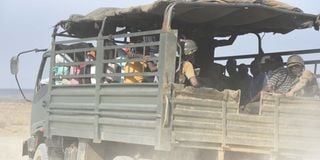
Ms Evalyne Ekaudu, another resident, said the bridge was too narrow for vehicles.
Attacks have also paralysed public transport in the affected villages for years, forcing locals to rely on the security forces stationed there for transport escorts.
Residents of border villages seeking medical care or running errands in larger towns, or traders going to buy food, have to climb lifts or seek escort from police vehicles in the area.
"Although the police vehicles are not safe from attacks, they are better than the public service vehicles. Often the police trucks are escorted by armoured vehicles until they cross the bridge, for added security in case of an ambush.
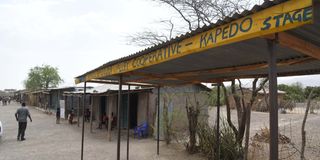
Kapedo trading centre on the border of Turkana and Baringo counties on February 17, 2023.
Tarmac road recommendation
Locals and security officials, however, recommend that a tarmac road be built from Chemolingot-Lomelo to Lokori to facilitate transport and reduce exposure to rampant attacks by armed criminals.
"Before the tarmac is built, as a short-term measure, the government should consider raising the bridge so that motorists using the route can see what is ahead. There have been several attacks in this area, especially at the bridge, but nothing has been done to remedy the situation," said Mr Francis Lopalal, a Kapedo resident.
When Defence Cabinet Secretary Aden Duale visited Baringo last week, Tiaty MP William Kamket and his Turkana East counterpart Nicholas Ngikor suggested that a tarmac road be built in the troubled region to ease transport and deter criminals who hide in the ravines around the dilapidated Murram road.





